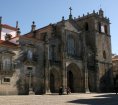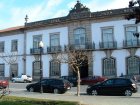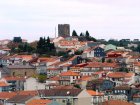Vila Real, Peso da Régua and Lamego, three cities belonging to the same natural and economic unit, the Alto Douro Vinhateiro (Upper Douro Winegrowing Region), strongly interconnected through institutional, social, economic and cultural ties which have increased over the last few years.

Territory
|

95 672 inhabitants
|

Of total population of NUT III Douro
|

Of Resident Population in Cities of NUT III Douro
|
Due to its antiquity – tradition has it that the first courts of the Portuguese kingdom met in Lamego, at the Santa Maria de Almacave Church, between 1142 and 1144, where King Afonso Henriques was crowned King of Portugal – and its vast heritage, the city of Lamego has not only gained a privileged position in history, but is history in itself. This history is not just what is written down on parchment scrolls, but is also recorded in the medieval streets, in the architecture of its buildings and in its monuments.
As a result of its cultural heritage par excellence, Lamego is a highly dynamic city in the tourist sector, as attested by a wide range of accommodation facilities (hotels and resorts, self-catering accommodation and rural tourism) scattered all over the municipality, as well as other tourist facilities which have added quality to the sector over the last few years.
Lamego, which inevitably claims the status of city of historical heritage and tourism in this Urban Axis, is also the main city in the Southern Douro Valley, its geographical location being of great relevance to the transition from the Beiras to the Douro regions, a status that was reinforced by the construction of the structural IP3/A24 road axis consolidating its role within the regional urban system and the possibilities for reviving the social and economic fabric.
It is clear, therefore, that the characteristics and roles of each of these three cities provide objective conditions for the creation of an urban network that exploits and provides leverage for their complementarities, without compromising the unique identity of each of them.
Lamego, which inevitably claims the status of city of historical heritage and tourism in this Urban Axis, is also the main city in the Southern Douro Valley, its geographical location being of great relevance to the transition from the Beiras to the Douro regions, a status that was reinforced by the construction of the structural IP3/A24 road axis consolidating its role within the regional urban system and the possibilities for reviving the social and economic fabric.
It is clear, therefore, that the characteristics and roles of each of these three cities provide objective conditions for the creation of an urban network that exploits and provides leverage for their complementarities, without compromising the unique identity of each of them.
Three cities – One territory
Vila Real, Peso da Régua and Lamego, three cities belonging to the same natural and economic unit, the Alto Douro Vinhateiro (Upper Douro Winegrowing Region), strongly interconnected through institutional, social, economic and cultural ties which have increased over the last few years.
This territory forms an Urban Axis just over 15 km long, with a population of around 93,700 inhabitants, which accounts for 44% of the total population in NUT III Douro, and 88% of people living in cities. With their own identities and character, the three cities complement and strengthen each other.
The Importance of an Urban Network
The past decades have placed enormous developmental challenges on cities and territories. The demands imposed by globalisation for increased efficiency, stronger competitiveness, increased growth and more knowledge, have brought about degradation processes in vast less equipped and peripheral areas, contributing to their decline and even jeopardising their viability. Territories and their people attempt to counter this trend by inventing new solutions that enhance their intrinsic and unique qualities, and which they use as a driving force for development. Within this context, a network of medium-sized cities integrated into depressed areas emerges as an innovative process seeking, through institutional cooperation, to create synergies for establishing a sustainable model for development, based on the complementarity of roles and attributes geared towards attracting investment, creating dynamics and generating knowledge.
By establishing networks, medium-sized cities are able to meet the demands of the global world, which they would not be able to do in isolation. By proactively involving public and private stakeholders, this facilitates the combination of competence, financial resources and growth in scale, and the emergence of attractive, socially cohesive territories, capable of international projection and providing quality of life for their populations.
The Douro Alliance – Eixo Urbano do Douro foundation, created by the strategic players in Vila Real, Peso da Régua and Lamego, is primarily justified by their territorial proximity, their complementarities and interdependencies and the political will demonstrated to develop an active, lasting cooperation with a view to gaining dimension, critical mass and reinforcing competitiveness and innovation. This Axis will thus gather together the conditions to become the economic and developmental driving force for the whole region, standing out as the major city of the Douro and Northern Interior region.
The genesis of this cooperation network is not a recent process. As early as the 1990s, the then Minister for Planning and Territorial Administration, Prof. Luís Valente de Oliveira, argued for the creation of this Urban Axis. In October 1994, the Mayors of these cities signed a City Contract that championed joint efforts in the pursuit of a common development strategy.
This territory forms an Urban Axis just over 15 km long, with a population of around 93,700 inhabitants, which accounts for 44% of the total population in NUT III Douro, and 88% of people living in cities. With their own identities and character, the three cities complement and strengthen each other.
The Importance of an Urban Network
The past decades have placed enormous developmental challenges on cities and territories. The demands imposed by globalisation for increased efficiency, stronger competitiveness, increased growth and more knowledge, have brought about degradation processes in vast less equipped and peripheral areas, contributing to their decline and even jeopardising their viability. Territories and their people attempt to counter this trend by inventing new solutions that enhance their intrinsic and unique qualities, and which they use as a driving force for development. Within this context, a network of medium-sized cities integrated into depressed areas emerges as an innovative process seeking, through institutional cooperation, to create synergies for establishing a sustainable model for development, based on the complementarity of roles and attributes geared towards attracting investment, creating dynamics and generating knowledge.
By establishing networks, medium-sized cities are able to meet the demands of the global world, which they would not be able to do in isolation. By proactively involving public and private stakeholders, this facilitates the combination of competence, financial resources and growth in scale, and the emergence of attractive, socially cohesive territories, capable of international projection and providing quality of life for their populations.
The Douro Alliance – Eixo Urbano do Douro foundation, created by the strategic players in Vila Real, Peso da Régua and Lamego, is primarily justified by their territorial proximity, their complementarities and interdependencies and the political will demonstrated to develop an active, lasting cooperation with a view to gaining dimension, critical mass and reinforcing competitiveness and innovation. This Axis will thus gather together the conditions to become the economic and developmental driving force for the whole region, standing out as the major city of the Douro and Northern Interior region.
The genesis of this cooperation network is not a recent process. As early as the 1990s, the then Minister for Planning and Territorial Administration, Prof. Luís Valente de Oliveira, argued for the creation of this Urban Axis. In October 1994, the Mayors of these cities signed a City Contract that championed joint efforts in the pursuit of a common development strategy.






















